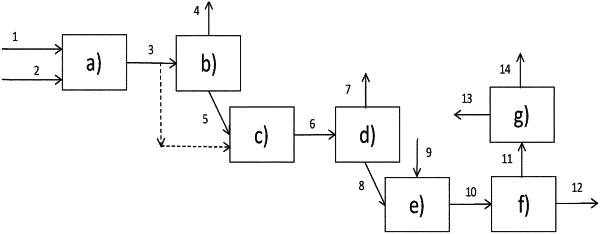| CPC C10G 31/06 (2013.01) [C10G 31/09 (2013.01); C10G 47/24 (2013.01); C10G 49/002 (2013.01); C10G 65/12 (2013.01); C10G 67/02 (2013.01); C10G 2300/1059 (2013.01); C10G 2300/202 (2013.01); C10G 2300/205 (2013.01); C10G 2300/206 (2013.01)] | 18 Claims |

|
1. A process for the treatment of a hydrocarbon feed containing at least one hydrocarbon fraction having a sulphur content of at least 0.1% by weight, an initial boiling point of at least 340° C. and a final boiling point of at least 440° C., said process comprising the following steps:
a) a fixed bed hydrotreatment step wherein the fixed bed hydrotreatment step is selected from the group consisting of hydrodenitrogenation, hydrodemetallization, hydrodeoxygenation, hydrodearomatization, hydroisomerization, hydrodealkylation, hydrocracking, hydrodeasphalting, Conradson Carbon reduction reactions and combinations thereof, and wherein the hydrocarbon feed and hydrogen are brought into contact over a hydrotreatment catalyst;
b) separating the effluent obtained from the hydrotreatment step a) into at least one light hydrocarbon fraction containing fuel bases and a heavy fraction containing compounds boiling at at least 350° C.,
c) a step of hydrocracking at least a portion of the heavy fraction obtained from step b) in at least one ebullated bed reactor containing a supported catalyst,
d) a step of separating the effluent obtained from step c) to obtain at least one gaseous fraction and at least one heavy liquid fraction,
e) a step of precipitating sediment, consisting of bringing into contact the heavy liquid fraction obtained from the separation step d) with a distillate cut wherein at least 20% by weight has a boiling point of 100° C. or more, for a period of less than 500 minutes, at a temperature in the range of 25° C. to 350° C., a pressure of less than 20 MPa, and in the presence of an oxidizing gas wherein the oxidizing gas is dioxygen, ozone or an oxide of nitrogen, and wherein part or all of the distillate cut originates from the separation step b),
f) a step of physical separation of the sediments from the heavy liquid fraction obtained from the precipitation step e) to obtain a liquid hydrocarbon fraction,
g) a step of recovering a liquid hydrocarbon fraction having a sediment content, measured in accordance with the ISO 10307-2 method, of 0.1% by weight or less, consisting of separating the liquid hydrocarbon fraction obtained from step f) from the distillate cut introduced during step e), and
wherein the weight ratio between the distillate cut and the heavy fraction obtained from the separation step b) is in the range of 0.05 to 10.
|